Marengo Wind Farm is an electricity generating wind farm facility located near Dayton, Washington, United States. It is owned by PacifiCorp and began operations in 2007. The facility has a generating capacity of 140 megawatts. [1] [2]

Solar Energy Generating Systems (SEGS) is a concentrated solar power plant in California, United States. With the combined capacity from three separate locations at 354 megawatt (MW), it was once the world's second largest solar thermal energy generating facility, after the commissioning of the even larger Ivanpah facility in 2014. It consisted of nine solar power plants in California's Mojave Desert, where insolation is among the best available in the United States.
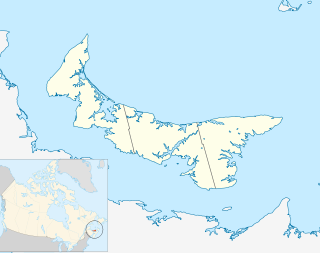
North Cape is a cape at the northwesternmost extremity of Prince Edward Island, Canada. It is located within the community of Seacow Pond.
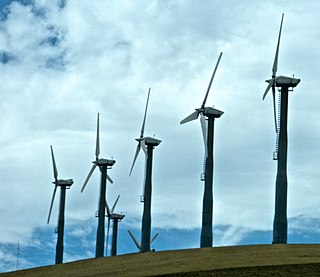
The Altamont Pass wind farm is located in the Altamont Pass of the Diablo Range in Northern California. It is one of the earliest wind farms in the United States. The first wind turbines were placed on the Altamont in the early 1980s by Fayette Manufacturing Corporation on land owned by cattle rancher Joe Jess. The wind farm is composed of 4930 relatively small wind turbines of various types, making it at one time the largest wind farm in the world in terms of capacity. Altamont Pass is still one of the largest concentration of wind turbines in the world, with a capacity of 576 megawatts (MW), producing about 125 MW on average and 1.1 terawatt-hours (TWh) yearly. They were installed after the 1970s energy crisis in response to favorable tax policies for investors.

Wind power in Ohio has a long history, and as of 2016, Ohio had 545 megawatts (MW) of utility-scale wind power installations installed, responsible for 1.1% of in-state electricity generated. Over 1000 MW more were under construction or pending approval. Some installations have become tourist attractions. There has been a sudden increase in generating capacity, as total wind power capacity in the state was just 9.7 MW in 2010. By 2019, there were 738 MW of capacity, which generated 1.71% of Ohio's electricity.
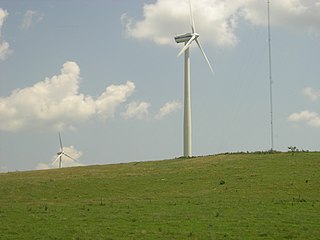
The Madison Wind Farm is a power generation plant located in the town of Madison, New York. Constructed in 1999-2000, it was the first wind farm completed in New York state and the first merchant wind farm in the country. The power plant consists of seven Vestas V66-1.65 MW wind turbines, generating enough energy to power up to 10,000 homes. The Vestas V66-1.65 MW wind turbines have a hub height of 67m and a 66m rotor diameter totally 100m to the top of the rotor

There are a number of wind power projects in the state of Maine, totaling more than 900 megawatts (MW) in capacity and responsible for 13.85% of in-state electricity production in 2017. In 2019, Maine had more wind capacity than the other five New England states combined, at 923 MW.
Port Alma Wind Farm is a large wind farm project located on the north shore of Lake Erie in the Municipality of Chatham–Kent, Ontario, Canada.
The White Creek Wind Farm is an electricity generating wind farm facility in Klickitat County, Washington, United States. It is owned by Last Mile Electric Cooperative and began operations in 2007. The facility has a generating capacity of 205 megawatts.
The Hopkins Ridge Wind Farm is an electricity generating wind farm facility located in Columbia County, Washington, United States. It is owned by Puget Sound Energy and began operations in 2005, built by RES Americas, a part of the Renewable Energy Systems Group. After a second phase of construction in 2008, the facility has a generating capacity of 157 megawatts, up from 149 megawatts. In the past, the energy output of Hopkins Ridge and Wild Horse Wind Farm has been sold to various California utilities through power purchase agreements.
The Hay Canyon Wind Farm is an electricity generating wind farm facility located in Moro, Oregon, United States. It is owned by Iberdrola Renewables and began operations in 2009. The facility has a generating capacity of 101 megawatts. The farm sells power to the Snohomish County Public Utility District.
The Leaning Juniper Wind Project is an electricity generating wind farm facility located in Gilliam County, Oregon, United States with a total generating capacity of 301.5 megawatts. It is owned by PacifiCorp and began operations in 2006. Leaning Juniper I became operational in September 2006 with 67 1.5 MW wind turbines with a capacity of 100.5 megawatts. "Leaning Juniper II includes 133 GE 1.5 MW wind turbines with a capacity of 201 MW. This phase came online in 2011." The Jones Canyon Substation was built as part of this project and to support other wind projects in the area.
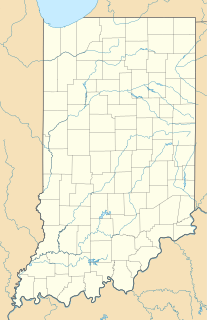
Wind power in Indiana was limited to a few small water-pumping windmills on farms until 2008 with construction of Indiana's first utility-scale wind power facility, Goodland with a nameplate capacity of 130 MW. As of September 2017, Indiana had a total of 1897 MW of wind power capacity installed, ranking it 12th among U.S. states. Wind power was responsible for 4.8% of in-state electricity production in 2016.
The Lower Snake River Wind Project is the newest and largest wind farm operated by Puget Sound Energy, and is located in Washington’s Garfield and Columbia counties. The wind farm is made up of 149 Siemens wind turbines rated at 2.3 MW each for a maximum generating capacity of 343 MW. The project was estimated to create up to 150 temporary jobs and 25 permanent jobs.

Energy in Hawaii is a mixture of fossil fuel and renewable resources. It is complicated by the state's isolated location and lack of fossil fuel resources. The state relies heavily on imports of petroleum and coal for power. Renewable energy production is increasing. Hawaii has the highest share of petroleum use in the United States, with about 62% of electricity coming from oil in 2017. As of 2016, 26.6% of electricity was from renewable sources, including solar, wind, hydro and geothermal.

Wind power in Rhode Island is in the early stages of development. There are several small scale wind turbine projects in the state. As of December 2013 there were 11 turbines at 10 sites in the state. In 2014, Rhode Island had 9 MW of installed wind power capacity, which quickly rose to 75 MW in 2019.
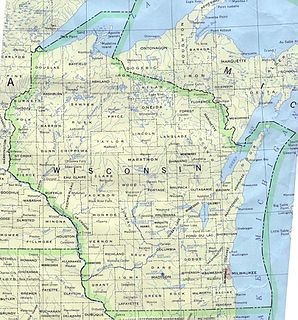
Wind power in Wisconsin started in 1990 with the installation of the Lincoln Turbines wind farm, and contributes to the state's renewable portfolio standard established in 1998. In 2016, Wisconsin had a wind generating capacity of 648 megawatts (MW), responsible for generating 2.4% of its electricity. In 2019, this increased to a capacity of 737 MW, and a 2.63% of generation.
Wind power in Arkansas remains nearly untapped. As of 2019, little to none of the state's electricity was produced by wind turbines. As of 2015, Arkansas had not established a renewable portfolio standard. Studies have concluded that while Arkansas is generally considered to have low wind resources, there are significant pockets of it throughout the state.
Coordinates: 46°22′27″N117°46′36″W / 46.37417°N 117.77667°W